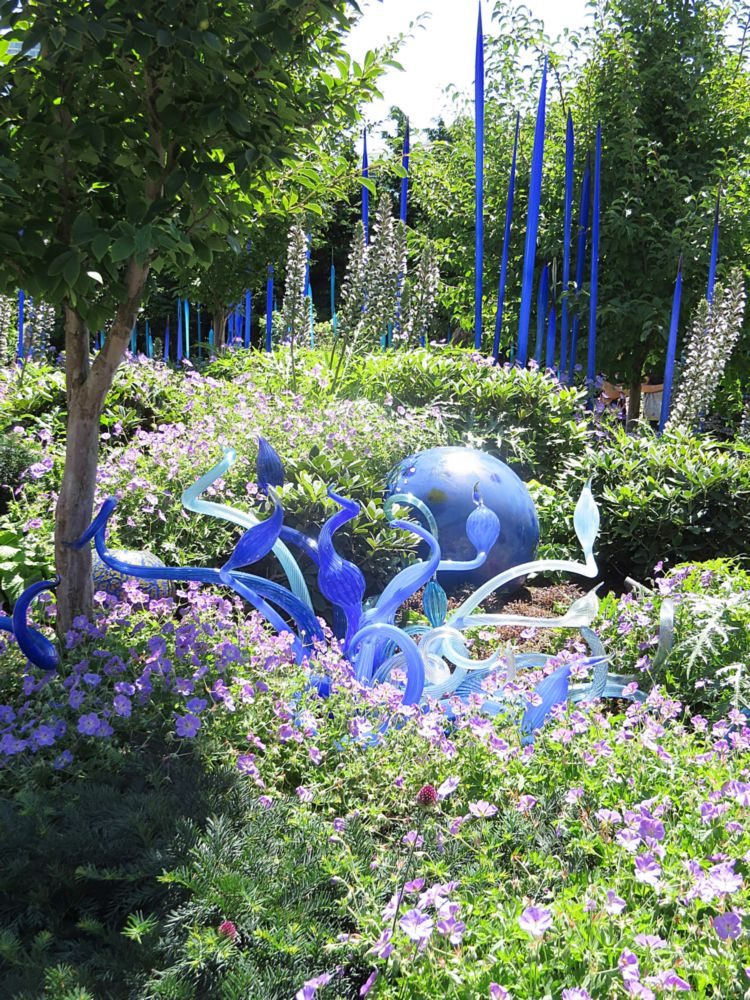I was first captivated by Dale Chihuly’s glass sculptures in an exhibition of his work at the Palm House in Kew Gardens in 2005, and so the visit to the Chihuly Garden and Glass was always going to be one of the highlights of my time in Seattle. Some of Chihuly’s work is particularly well-suited for display in garden settings, particularly small glass sculptures which seem like other-worldly flowers and provide a wonderful complement to exotic tropical foliage.
Chihuly’s work has been displayed at over a dozen botanical gardens such as Kew, but his most ambitious public installation was in Israel and entitled ‘Chihuly in the Light of Jerusalem’ and was seen by over a million visitors.
The Chihuly Garden and Glass, beside the Space Needle in Seattle, opened in 2012 and is a series of permanent gallery spaces displaying his spectacular work, together with a conservatory and a garden.
Dale Chihuly was born in 1941, to a Native American couple living in Tacoma some 35 miles south of Seattle. His mother encouraged his artistic talent and he completed a BA in Interior Design and a Masters in Sculpture. His prodigious talent was recognised early in his career and led to scholarships allowing him to travel to Venice and work at the prestigious Venini glass factory on the island of Murano.
Following a car accident in England in 1976 when he was blinded in one eye, and a body-surfing accident three years later that left him with a dislocated shoulder and unable to hold a glass-blowing pipe, he built up a team of master glass-blowers and assistants. He subsequently described his role as ‘more choreographer than dancer, more supervisor than participant, more director than actor’. This role has allowed him to stand back and has encouraged him to create more ambitious installations, developing a whole range of innovative techniques such as ‘seeding’ molten glass with shards and small pieces of different colours. He has struggled with bi-polar disorder which sees his moods swing from despair to elation, making it difficult at times for him to work.
Chihuly is perhaps best known for his huge glass chandeliers, one of which hangs in the main entrance hall of London’s Victoria and Albert Museum, whilst many of his small domestic-scaled pieces are elegant shell-like shapes in vibrant colours.
Most of his work in the Seattle garden is of groups of small glass forms; organic, translucent and pigmented pieces skilfully placed to complement the colour palette of the planting. However, the layout and the plant combinations themselves are disappointing and the choice of cottage-style planting of geraniums, hydrangeas and calla lilies works less well with his pieces than it does with tropical planting. What is surprising is that the large conservatory alongside the garden is empty apart from an enormous suspended glass sculpture of flowers some 120 feet (36 metres) long. This space would make an ideal setting for pieces of his work displayed amongst large-leaved and exotic tropical foliage.
Chihuly is a very successful entrepreneur as well as a wonderful artist, and the cost of entry may seem high; but in my view it is justifiable considering the quality of the displays in the galleries, the exquisite lighting, difficulty in cleaning the pieces and the levels of security required to keep inquisitive children from climbing on or touching the fragile pieces.
Contemporary artwork and installations seem to have taken a different direction, and are seldom a wonderful, elegant and breath-taking celebration of nature, having a wide appeal to all ages. This makes the Chihuly Garden and Glass a remarkable, beautiful and exhilarating experience, one that I would look forward to revisiting time and time again.
August 2018
***
Where: Chihuly Garden and Glass, 305 Harrison Street, Seattle 98109
Website: www.chihulygardenandglass.com
| Setting | 7/10 | Interest for Children | 10/10 |
| Concept | 10/10 | Accessibility | 10/10 |
| Design Execution | 10/10 | Café | 5/10 |
| Hard Landscaping | 5/10 | ||
| Planting | 5/10 | ||
| Maintenance | 8/10 | ||
| Garden | 45/60 | Facilities | 25/30 |








